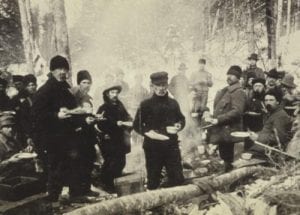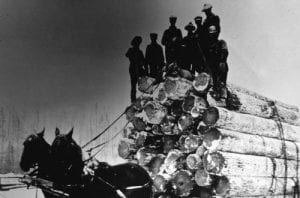The Lumber Trade In The 1800s
 The sandy soil of Wasaga made this area unattractive to settlers looking to farm here. By the 1820s, the first sign of settlement in the area began as John Goessman surveyed Flos Township. In 1826, land was being sold for four shillings an acre and by the 1830s he had officially surveyed most of the land in this area.
The sandy soil of Wasaga made this area unattractive to settlers looking to farm here. By the 1820s, the first sign of settlement in the area began as John Goessman surveyed Flos Township. In 1826, land was being sold for four shillings an acre and by the 1830s he had officially surveyed most of the land in this area.
Although unsuitable for farming, the Wasaga area had an abundance of trees. In the late 1830s, and throughout the rest of the century, the logging industry would play an important role in the development of the area. The Nottawasaga River served as a natural route for timbers to be transported to the lumber mills. There were several mills up the river and larger mills across the bay in Collingwood.
 As the industry flourished, several proposals were made for the construction of either a railway or canal that would end at the mouth of the Nottawasaga River. The proposal for the canal would have run from Lake Ontario to Lake Huron, utilizing the Nottawasaga River for the latter part of the route. Although several surveys for the canal were done, the plan proved to be too expensive and the canal was never built. The proposition for a railway would have seen a route connecting York (Toronto) to Georgian Bay; however, due to the lack of funding and an uncertain political climate, this scheme was postponed. In 1844 the scheme was revived and in 1851 construction began on the first leg of the line which was to run to Barrie. In 1852, various routes to Georgian Bay were surveyed and two of these led to the mouth of the Nottawasaga.
As the industry flourished, several proposals were made for the construction of either a railway or canal that would end at the mouth of the Nottawasaga River. The proposal for the canal would have run from Lake Ontario to Lake Huron, utilizing the Nottawasaga River for the latter part of the route. Although several surveys for the canal were done, the plan proved to be too expensive and the canal was never built. The proposition for a railway would have seen a route connecting York (Toronto) to Georgian Bay; however, due to the lack of funding and an uncertain political climate, this scheme was postponed. In 1844 the scheme was revived and in 1851 construction began on the first leg of the line which was to run to Barrie. In 1852, various routes to Georgian Bay were surveyed and two of these led to the mouth of the Nottawasaga.
Plans for a town named Hythe to be established at the mouth of the river were made as the district was poised for development that the railway would bring. Establishing a commercial harbour at the mouth of the Nottawasaga was viable as the schooners, tugs, and steamers of the day easily navigated the lower reaches of the river. However, in 1852 an unfortunate event occurred which influenced the future of Wasaga Beach.
A large schooner from Buffalo was caught in a storm offshore where it was to be loaded with grain. The doomed vessel could not enter the Nottawasaga River because it would have been too heavy once loaded to leave the river. Therefore, caught in the open shallow bay, the empty boat was run aground. Waves battered the vessel causing it to break up and the schooner was destroyed.
This wreck outlined the deficiencies of using the Nottawasaga River as a harbour and officials then decided to end the rail line several miles west in what is now Collingwood. With this decision, Wasaga Beach remained an area for logging and small scale fishing for the following decades.
Finally, in 1870 a man named John Van Vlack purchased 69 acres of land near the Nottawasaga River and would be one of the area’s first permanent resident’s. He then paved the way for more intense settlement and the construction of a village. Van Vlack fished commercially, and established a shingles mill when he arrived and also operated a general store and soon became the first postmaster for the area. A small village eventually grew around the Van Vlack property that was populated by millhands and other settlers. By 1896, a population of 70 resided in what was known as Van Vlack. Two years after Van Vlack arrived a bridge was built over the river, and by the mid 1880s a woman named Jane Summerfeldt recognized the tourism potential and opened a hotel in the village. Much of the settlement at this time was connected to logging and the fishing industry; however, agricultural development around the fringes of the Wasaga area began to take place in the 1880s.
Early farmers grew turnips, oats, wheat, and peas; more prosperous farms also owned horses and oxen. It was in this period that the first official use of the name Wasaga Beach occurred. During the division of lots in Sunnidale Township, one subdivision was named Wasaga Beach which was derived from the word Nottawasaga. This name seemed to take time to be used because the Elmvale Chronicle continued to refer to this area as “the Beach” throughout the 1890s.
As the century grew to a close, the logging industry dwindled when most of the larger trees were removed; however, there were still enough resources to maintain the mill at Van Vlack until 1914. The settlement of Wasaga Beach was gradual and today owes much of its credit to John Van Vlack, early lumbercamp workers, millhands, and their families who worked hard to develop the beginnings of the present town.
